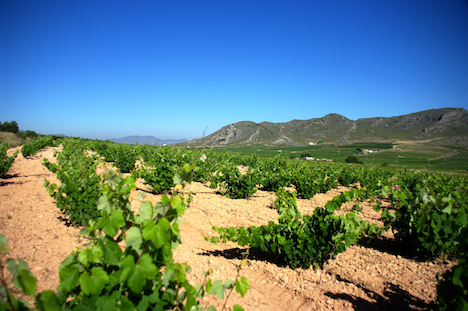Murcia, Spain. As you tour this parched semi-arid corner of eastern Spain, two realities are inescapable: the sun rules and water is a scarce commodity.
The harshly beautiful landscape is marked by massive limestone outcrops that punctuate the seemingly always clear and azure sky, their steep, southern slopes rock pocked and treeless, embracing lower plantings of almonds, olives and vines.
Once established, Monastrell vines somehow manage to thrive thanks to their ability to reach down through the chalky clay soils of the lower valleys, from which the joven or young wines are mainly produced,
More complex, often distinctly mineral wines are made with grapes grown on higher more stony slopes, particularly on the aptly named Altiplano that joins Jumilla and Yecla DO regions.
Winemaking here dates back some 2000 years to Roman times, while the modrn industry has its roots in the arrival of French traders who came post-Phylloxera in the mid 19th century. Many older country homes still have stone tanks hewn into their rocky foundations where for generations people have stored their own wine.
Monastrell from Yecla, Jumilla and Bullas is gaining ground on more familiar Tempranillo, for which more northern Rioja has now become famous. Increasingly winemakers are finding success with blends that incorporate varieties such as Syrah and Garnacha, which make sense in a climate and terroir that being just 80 kms. inland is part way between Mediterranean and Continental.
As the thermometer climbs into the 30s, while this is serious red wine country, more producers are also starting make very solid rosés. It’s the natural (and very Mediterranean) complement to foods such as octopus (pulpo), zarzuela (the Spanish equivalent to Bouillabaisse), ubiquitous jamon (ham)—and even goes well with the simple lettuce, tomato and anchovy stuffed olive salad, which is lightly dressed with excellent local olive oil.
While on the coast, paella, based mainly on seafood ingredients, is a staple, inland the more celebrated dish is arozz conejo y caracoles, a delicious rice dish with rabbit and escargots, sometimes prepared over an open vine cutting fueled fire, as at Restaurante Casa Ricardo in Raspay. Our match here is the refreshingly balanced, strawberry, raspberry and slightly earthy 09 Rosé (Monastrell, Syrah, Cab-Sauv, Garnacha) from Bodegas Castano (PWS $15-$17).
Jumilla and Yecla now produce no shortage of good rosés, well suited to less flammable BC barbequeing, including the eminently drinkable Olivares 09 Rosé (Jumilla, $13.99), with vibrant red berry notes, fresh and fruity with moderate acidity that makes it also the perfect summer sipper. (BCLS $13.99)
Hopefully, some savvy importer will also latch onto the week’s bargain taste, the well made budget priced Estio Rosé 09, from the region’s largest producer La Purisima Cooperative—which should be hitting shelves at under $10—but isn’t. Yet.

Leave A Comment